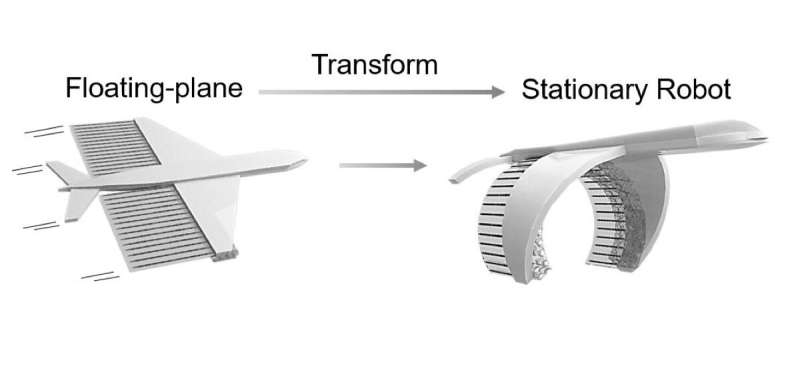Toy transformers and real-life whales inspire biohybrid robot

Drawing inspiration from biology and the toy shelf, researchers at Thayer School of Engineering at Dartmouth College and City University of Hong Kong have developed a swimming robot with a light-controlled cellular engine that can perform highly-targeted drug delivery.
Researchers combined cardiac tissue engineering, a 3-D-printed wing structure and a light-sensitive gel to produce the soft robot with start-stop capability. The switchable device transforms its shape when exposed to skin-penetrating near-infrared light, causing it to drive and brake through fluid environments like the human blood stream.
The transformable device dramatically improves the usefulness of robots designed to work inside the human body and other unconventional work environments.
The research team at City University of Hong Kong produced the original robot design and performed the experimental tests. The Dartmouth team performed mechanical and numerical analysis on the device and suggested changes to design elements like size and shape.
"With this technology we can create soft transformable robots with unprecedented maneuverability," said Zi Chen, an assistant professor of engineering at Thayer. "Our inspiration came from transformable toys that have different configurations and functionality. The result is no toy, it may literally change people's lives."
Living organisms are capable of changing shapes to perform specific actions. A hedgehog curls into a ball for defense. Birds spread their wings to fly. Carnivorous plants such as the Venus flytrap open and close. The new study is part of a long-term effort to develop robots that mimic this shape-changing behavior found in nature.
To be effective, the new generation of robots need to be energy efficient and they must be able to respond to different types of stimulus, like light or heat.
While examples of these types of robots already exist, researchers have struggled to create a device that fluently transforms its shape to allow it to start and stop moving on demand. Most existing systems also depend on temperature variations that are difficult to stimulate in the human body because of its nearly-constant temperature.
"The ability to control the robot's motion using light creates a much more functional device that can be operated with high precision," said Xiaomin Han, a recent Ph.D. graduate from the Chen Research Lab at Thayer.
The remote-controlled robot is driven by a tail fin that mimics the swimming action of whales. The structure was 3-D printed in the shape of an airplane wing and then coated with heart muscle cells. In the same way that cardiomyocytes cause the heart to beat continuously, they also propel this biohybrid device through a constant undulating action.
To control the movement of the robot, researchers applied photosensitive hydrogels to the wings. In the absence of light, the wings deploy, allowing the heart cells to propel it forward. When exposed to light, the floating plane retracts its wings, causing it to stop.
"The heart muscles keep churning, but they are unable to overcome the stopping power of the wings," said Chen. "It's like pushing the accelerator pedal with the emergency brake on."
The robot's high sensitivity to near-infrared light creates a response rate that allows an almost immediate transformation of wing shape, allowing it to be highly maneuverable. In the study, researchers used the "unprecedented controllability and responsiveness" of the floating-plane robot as a cargo carrier to conduct targeted drug delivery against cancer cells.
"We literally dropped drug bombs on cancer cells," said Chen. "The realization of the transformable concept paves a pathway for potential development of next-generation intelligent biohybrid robotic systems."
The biohybrid robot can be produced in a variety of sizes ranging from several millimeters to dozens of centimeters. Such scalability gives it good flexibility to take on tasks related to navigation and surveillance in difficult environments.
A study describing the research first appeared in the academic journal Small in late March.
In the current study, researchers control start-stop motion of the entire robot though the use of light. Future research will use light to target separate wings on the robot so that it can be steered with even more precision.
This research was produced with Peng Shi and Bingzhe Xu from City University of Hong Kong. Yuwei Hu and Chia-Hung Chen from National University of Singapore and Yiming Luo from Hubei University of Technology also contributed to the study.
More information: Bingzhe Xu et al, A Remotely Controlled Transformable Soft Robot Based on Engineered Cardiac Tissue Construct, Small (2019). DOI: 10.1002/smll.201900006



















